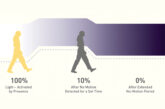
What are Unified Glare Ratings (UGR) and how do you calculate them? The team at ROBUS provides us with the answers.
The visual sensation of Unified Glare occurs when there is excessive and uncontrolled brightness.
There are two commonly considered types of glare: the type that can be disabling and the kind that can simply be uncomfortable. Whilst glare is subjective and sensitivity to it can vary greatly, the ageing and shaping characteristics of the human eye also play a part. Often, the more senior the user the more susceptible to glare they become.
Discomfort glare
Overly bright light sources can induce annoyance or even pain, but they do not actually impair vision.
Disability glare
Intense light sources in the field of view causing the reduction in visibility. It causes a loss of visibility from stray light being scattered within the eye.
Minimising direct glare
Lighting arrangements and cut-off angles are two of the most important factors for minimising direct glare from luminaires. However, the UGR value as a measurement of direct glare does not depend on the individual luminaire, but rather on the room and the viewer’s position within each workspace.
Unified Glare Ratings, simplified as UGR, are calculated using a precise formula. Essentially, this formula measures the luminance of a luminaire divided by the background of visible luminance from the room.
In order to truly calculate UGR, at the design stage, RAL numbers of wall and floor coverings would enable the truest form of calculation. In many cases this information is yet to be defined so designers refer to a default set of reflectances.
The UGR ranges from 5 to 40. The lower the number, the lower the generated glare. For example, a UGR of 10 would mean the glare is so discreet it will go unnoticed and create a comfortable working environment, while a UGR of 30 will cause distraction and potentially discomfort to the user.
UGR is applicable to lighting installations, not luminaires. The formula requires the prior knowledge of the position and brightness of each potential glare source, so is often calculated once a lighting design has been finalised.
UGR calculations are accurate, but relatively difficult to work with, so they’re often calculated with the use of computer software. Calculating glare involves summing all the light coming from all sources at a particular angle entering the eye at a particular location within each room. UGR recommendations are pre-determined and set by SLL in the UK and Ireland. A brief and short form example of this can be seen in the table below.
The calculation of UGR is independent of the height of the luminaires above the observer’s eye (H) with luminaire spacing (also = H), as H changes the size of the room and spacing of the luminaires. A typical UGR table is shown in the image (pictured below).
You should follow these steps to determine the UGR value:
– Determine room size. This can be expressed in terms of the number of luminaires in each direction.
– Determine reflectances of the room surfaces.
– Generally, we would assume most spaces would conform to the first two columns of each row.
– Determine viewing direction: crosswise or endwise relative to the luminaire dimensions.
– Read the UGR value from the table.
Strictly speaking, there is no such thing as a ‘UGR19-compliant’ luminaire in itself. Luminaires do, however, support the performance of a UGR-compliant design or installation.
Full compliance can only be determined once the ergonomics and geometry relative to the occupants of a space have been assessed. The UGR calculation of a room where multiple luminaire types are utilised will be calculated based upon the product with the greatest Unified Glare intensity.
If a manufacturer claims a product carries a UGR19 compliance, it can only be for a set of pre-determined conditions. A luminaire UGR is a way to simply determine if it is likely to cause any discomfort in specific types of work or office environment.
Browse the 2023 ROBUS Lighting catalogue here










